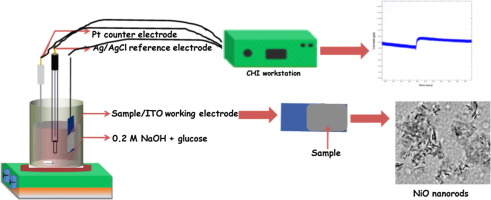Journal of Colloid and Interface Science ( IF 9.4 ) Pub Date : 2018-01-09 , DOI: 10.1016/j.jcis.2018.01.027 Nabanita Pal , Sangam Banerjee , Asim Bhaumik

|
In modern world, diabetes is one of the most leading diseases that cause human death and disability. Continuous effort to control and manage diabetes by acute monitoring of the blood glucose concentration requires the development of an efficient and reliable glucose sensing device. Although both enzymatic and enzyme-free methods of glucose detection are available in the market, non-enzymatic biosensors are more significant due to certain drawbacks in enzyme based sensors. In this article, a stable non-enzymatic sensing platform for d-glucose based on nickel hydroxide and nickel oxide nanomaterials has been described. Ni(OH)2 and NiO were synthesized through a facile hydrothermal route followed by the heat treatment. Detailed morphological and structural characterizations were carried out using PXRD, transmission and scanning electron microscopy) (TEM and FESEM) which reveal that hexagonal β-Ni(OH)2 and cubic NiO phases have been formed. TEM image of NiO has shown that the nanomaterials consist of ca. 10 nm sized rod like pattern distributed uniformly. Both Ni(OH)2 and NiO have shown excellent electrocatalytic activity towards enzyme-free glucose sensing under ambient condition. Glucose sensing investigation based on amperometric i-t curve performed in 0.2 M NaOH medium shows a good sensitivity of 12.09 µA mM−1 cm−2 and 24.0 µA mM−1 cm−2, respectively for Ni(OH)2 and NiO nanostructures. Interference test was done using reagents like ascorbic acid, uric acid and dopamine to confirm the selectivity of nickel hydroxide and oxide nanomaterials towards glucose analyte. So, the proposed Ni(OH)2 and NiO based electrodes can be used as a cost-effective, stable and non-air sensitive platform for non-enzymatic glucose detection.
中文翻译:

合成Ni(OH)2和NiO纳米结构作为非酶葡萄糖传感器潜在候选物的简便方法
在现代世界中,糖尿病是导致人类死亡和致残的最主要疾病之一。通过急性监测血糖浓度来持续控制和控制糖尿病需要开发一种有效且可靠的葡萄糖传感装置。尽管在市场上都可以买到酶促和无酶的葡萄糖检测方法,但是由于基于酶的传感器中的某些缺点,非酶促生物传感器更为重要。在本文中,已描述了一种基于氢氧化镍和氧化镍纳米材料的稳定的d-葡萄糖非酶感测平台。镍(OH)2NiO和NiO是通过简单的水热途径合成,然后进行热处理。使用PXRD,透射和扫描电子显微镜(TEM和FESEM)进行了详细的形态和结构表征,揭示了已形成六方β- Ni(OH)2和立方NiO相。NiO的TEM图像表明,纳米材料由大约20%的碳组成。10 nm大小的棒状图案均匀分布。Ni(OH)2和NiO对环境条件下的无酶葡萄糖感测均显示出优异的电催化活性。在0.2 M NaOH介质中进行的基于安培it曲线的葡萄糖感测研究显示良好的灵敏度为12.09 µA mM -1对于Ni(OH)2和NiO纳米结构,分别为 cm -2和24.0 µA mM -1 cm -2。使用抗坏血酸,尿酸和多巴胺等试剂进行干扰试验,以确认氢氧化镍和氧化物纳米材料对葡萄糖分析物的选择性。因此,提出的基于Ni(OH)2和NiO的电极可以用作非酶促葡萄糖检测的经济高效,稳定且对空气不敏感的平台。







































 京公网安备 11010802027423号
京公网安备 11010802027423号